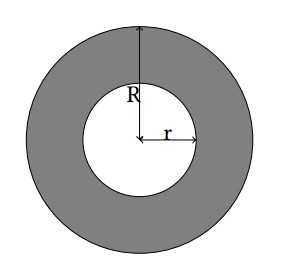HDU 5120 Intersection
Intersection
Problem Description
Matt is a big fan of logo design. Recently he falls in love with logo made up by rings. The following figures are some famous examples you may know.

A ring is a 2-D figure bounded by two circles sharing the common center. The radius for these circles are denoted by r and R (r < R). For more details, refer to the gray part in the illustration below.

Matt just designed a new logo consisting of two rings with the same size in the 2-D plane. For his interests, Matt would like to know the area of the intersection of these two rings.

A ring is a 2-D figure bounded by two circles sharing the common center. The radius for these circles are denoted by r and R (r < R). For more details, refer to the gray part in the illustration below.

Matt just designed a new logo consisting of two rings with the same size in the 2-D plane. For his interests, Matt would like to know the area of the intersection of these two rings.
Input
The first line contains only one integer T (T ≤ 105), which indicates the number of test cases. For each test case, the first line contains two integers r, R (0 ≤ r < R ≤ 10).
Each of the following two lines contains two integers xi, yi (0 ≤ xi, yi ≤ 20) indicating the coordinates of the center of each ring.
Each of the following two lines contains two integers xi, yi (0 ≤ xi, yi ≤ 20) indicating the coordinates of the center of each ring.
Output
For each test case, output a single line “Case #x: y”, where x is the case number (starting from 1) and y is the area of intersection rounded to 6 decimal places.
Sample Input
2
2 3
0 0
0 0
2 3
0 0
5 0
Sample Output
Case #1: 15.707963
Case #2: 2.250778
#include<iostream> #include<cmath> #include<cstdio> #include<cstring> #include<algorithm> using namespace std; typedef double db; const db PI=acos(-1.0); struct point { db x,y; }p[2]; struct circle { point O; db r; }C[4]; db distcal(point a,point b) { return sqrt((a.x-b.x)*(a.x-b.x)+(a.y-b.y)*(a.y-b.y)); } db areacal(circle a,circle b) { if(a.r>b.r)swap(a,b); db d=distcal(a.O,b.O); if(d==0.0||d+a.r<=b.r){db t=a.r;return PI*t*t;} if(a.r+b.r<=d)return 0.0; db th1=acos((a.r*a.r+d*d-b.r*b.r)/(2*a.r*d)); db th2=acos((b.r*b.r+d*d-a.r*a.r)/(2*b.r*d)); db are1=a.r*a.r*th1; db are2=b.r*b.r*th2; db are3=a.r*d*sin(th1); return are1+are2-are3; } int main() { int T; scanf("%d",&T); for(int kase=1;kase<=T;kase++) { db r,R; scanf("%lf%lf",&r,&R); scanf("%lf%lf%lf%lf",&p[0].x,&p[0].y,&p[1].x,&p[1].y); C[0].O=p[0],C[0].r=R; C[1].O=p[0],C[1].r=r; C[2].O=p[1],C[2].r=R; C[3].O=p[1],C[3].r=r; db ans=areacal(C[0],C[2])+areacal(C[1],C[3])-2.0*areacal(C[0],C[3]); printf("Case #%d: %.6f\n",kase,ans); } return 0; } /* 1 1 10 0 0 1 0 */


